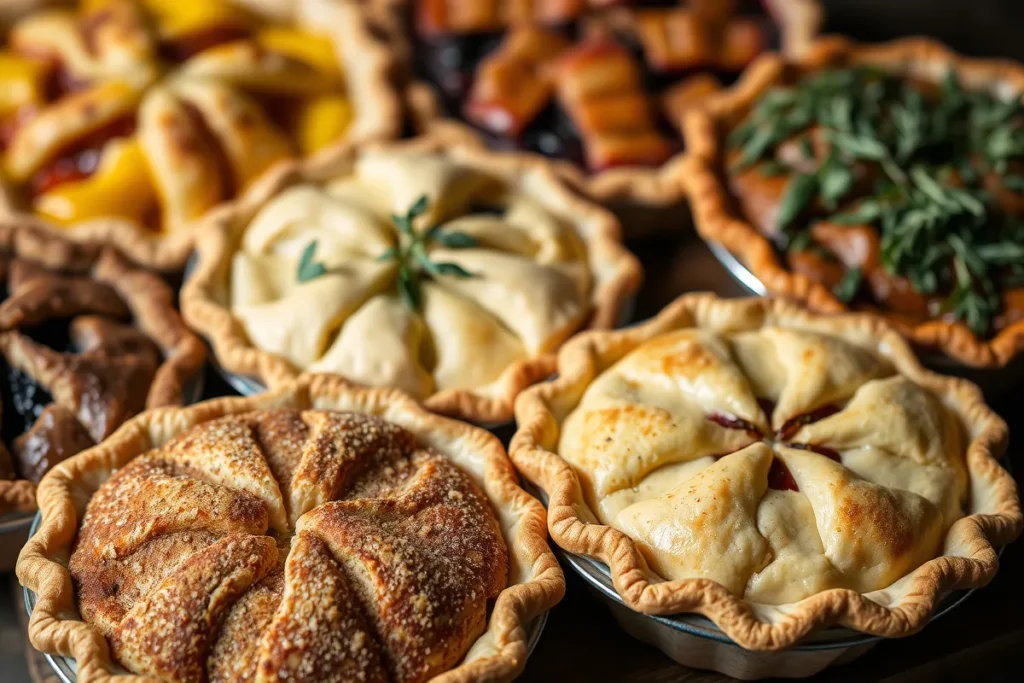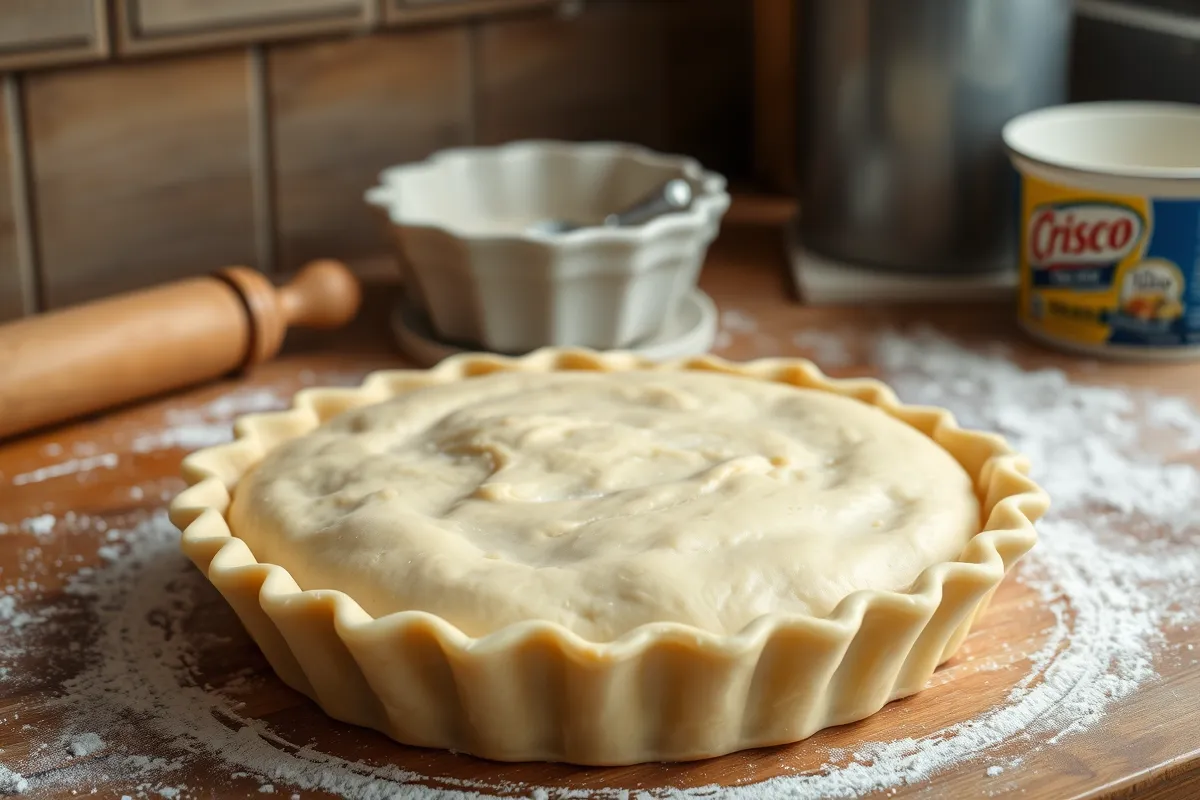Introduction
Pie crusts are the heart of many cherished recipes, from warm, homemade apple pies to savory pot pies. A Crisco pie crust recipe is a game-changer, offering unmatched flakiness and a tender texture that is easy to achieve.
Why choose Crisco? Unlike butter, Crisco is a vegetable shortening that ensures your crust remains pliable and easy to work with, while still delivering a light and crispy bite. This makes it ideal for both beginners and seasoned bakers alike.
In this guide, you’ll discover everything you need to know to create the perfect flaky Crisco pie crust. From understanding the ingredients to mastering the techniques, this recipe will become your go-to for all your pie-making needs.
What is Crisco?
Crisco is a versatile vegetable shortening that has been a staple in kitchens for over a century. Known for its neutral flavor and unique consistency, it is widely used in baking to create tender and flaky pastries, including pie crusts.
Origins of Crisco
Crisco was introduced in 1911 as a plant-based alternative to lard. Its innovative formula made it an instant success among home cooks and professional bakers alike. Unlike butter or lard, Crisco is entirely plant-based, making it a popular choice for those seeking a dairy-free option.
Why Choose Crisco for Pie Crusts
Crisco has several advantages that make it perfect for pie crusts. First, it stays stable at room temperature, meaning it doesn’t melt as quickly as butter, giving you more time to work with the dough. This stability is key to achieving a flaky Crisco pie crust, as it allows for the creation of air pockets that form during baking.
Additionally, Crisco’s neutral flavor ensures the pie filling remains the star of the show. While butter adds richness, Crisco creates a texture that is light, delicate, and just as satisfying.
Transitioning to Crisco from butter or lard might seem like a small change, but it can transform your pie crust-making process for the better.
Ingredients for a Perfect Crisco Pie Crust
A Crisco pie crust recipe requires only a handful of ingredients, making it both simple and affordable. However, the key to success lies in using the right proportions and ensuring the ingredients are prepared correctly.
Core Ingredients
To create a perfectly flaky Crisco pie crust, you’ll need the following essentials:
- Crisco Shortening: The star of the recipe, Crisco ensures a tender and flaky texture. Stick or tub forms both work well, but measure carefully for accuracy.
- All-Purpose Flour: Provides the structure for your crust. Choose high-quality flour for the best results, and sift it if needed to avoid lumps.
- Salt: Enhances the overall flavor of the crust. A small amount goes a long way in balancing the pie’s taste.
- Ice-Cold Water: Helps bind the dough without overhydrating it. The cold temperature prevents the shortening from melting prematurely.
Optional Additions
For those who like to experiment, you can customize your crust based on the type of pie you’re making:
- Sugar: Add a teaspoon or two for a slightly sweet crust, perfect for fruit pies.
- Spices: Cinnamon, nutmeg, or even a hint of cocoa powder can add complexity to your crust.
- Herbs and Cheese: For savory pies, mix in dried herbs like thyme or grated parmesan cheese for a flavorful twist.
Pro Tips for Ingredient Preparation
- Keep it cold: Store Crisco in the fridge before use and ensure your water is ice cold. This helps create a flaky texture.
- Use a pastry cutter or food processor: These tools can help blend the shortening and flour evenly without overworking the dough.
Now that you have the perfect ingredient list, it’s time to move on to the step-by-step guide to making a Crisco pie crust.
Step-by-Step Guide to Making Crisco Pie Crust
Making a Crisco pie crust recipe is simpler than it seems, but attention to detail is essential for a flawless result. Follow these steps for a crust that’s both tender and flaky.
Preparation Steps
Before starting, it’s important to set yourself up for success:
- Chill your ingredients: Place your Crisco in the refrigerator for at least 30 minutes. Use ice-cold water to ensure the shortening stays solid while mixing.
- Prepare your workspace: Lightly flour your work surface to prevent sticking, but don’t overdo it, as too much flour can toughen the dough.
Mixing the Dough
- Combine dry ingredients: In a large mixing bowl, whisk together the flour and salt. This ensures the salt is evenly distributed throughout the dough.
- Cut in the Crisco: Use a pastry cutter or two knives to blend the Crisco into the flour mixture. The texture should resemble coarse crumbs, with some pieces the size of small peas. This step is crucial for creating a flaky texture.
- Add water gradually: Sprinkle ice-cold water, one tablespoon at a time, over the mixture. Stir gently with a fork after each addition until the dough starts to come together. Avoid adding too much water, as this can make the crust tough.
Rolling and Shaping
- Form the dough into a ball: Once the dough holds together, divide it into two equal portions if you’re making a double crust. Flatten each portion into a disk, wrap in plastic wrap, and chill for at least 30 minutes.
- Roll the dough: On a floured surface, roll the dough from the center outward, turning it slightly after each roll to maintain an even thickness. Aim for a circle about 2 inches larger than your pie dish.
- Transfer to the pie dish: Carefully lift the dough using your rolling pin and drape it over the pie dish. Press it gently into the corners without stretching the dough, which can cause shrinking during baking.
Pre-Baking vs. Fully Baking
- Pre-baking (blind baking): For pies with no-bake fillings (like cream pies), pre-bake the crust. Line it with parchment paper and fill with pie weights or dried beans. Bake at 375°F (190°C) for 12–15 minutes, then remove the weights and bake for another 5–7 minutes until lightly golden.
- Fully baking: For pies with fully cooked fillings, bake the assembled pie according to the recipe’s instructions.
Now that you’ve mastered the process, you’re well on your way to enjoying a delicious flaky Crisco pie crust.
Troubleshooting Common Issues
Even with a foolproof Crisco pie crust recipe, sometimes things don’t go as planned. Here are some common problems and solutions to ensure your pie crust turns out perfectly every time.
Dough Crumbles or Tears
If your dough is falling apart or crumbling as you try to roll it, it’s likely too dry.
- Solution: Sprinkle a small amount of ice water—just one teaspoon at a time—onto the dough and gently knead it until it holds together. Be careful not to overwork it, as this can make the crust tough.
- Prevention Tip: Measure your water precisely and add it gradually to avoid dryness.
Shrinking During Baking
Shrinking pie crusts can ruin the appearance of your pie and make it difficult to fill properly.
- Solution: Chill the dough thoroughly before rolling and again before baking. This helps relax the gluten and prevents the crust from shrinking.
- Prevention Tip: Avoid stretching the dough as you press it into the pie dish. Instead, lift and gently fit it into the edges.
Lack of Flakiness
A pie crust that’s dense or lacks flakiness is usually caused by overmixing or using ingredients that are too warm.
- Solution: Ensure that your Crisco is well-chilled before mixing and that you don’t overblend the shortening into the flour. The small pea-sized pieces of Crisco are essential for creating flaky layers.
- Prevention Tip: Handle the dough as little as possible to avoid melting the shortening.
Tough Crust
A tough crust is often the result of overworking the dough or adding too much water.
- Solution: Start fresh if the dough feels overly stiff or elastic.
- Prevention Tip: Mix just until the dough comes together and avoid kneading it excessively.
With these troubleshooting tips, you’ll be able to tackle any issues and ensure your flaky Crisco pie crust is perfect every time.
Variations on the Classic Crisco Pie Crust
While the classic Crisco pie crust recipe is a timeless choice, adding your own twist can take it to the next level. Whether you’re making a savory quiche or a decadent dessert, these variations will inspire creativity in your baking.

Savory Crusts
For savory pies, such as chicken pot pies or vegetable tarts, consider enhancing the crust with bold flavors:
- Herbs: Mix in a teaspoon of dried rosemary, thyme, or oregano with the flour for a fragrant and flavorful crust.
- Cheese: Add 2–3 tablespoons of grated parmesan or cheddar cheese to the dough for a rich, savory edge.
- Spices: Incorporate ground black pepper or smoked paprika for a subtle kick.
Sweet Crusts
Sweetened pie crusts are perfect for fruit pies, custards, and tarts.
- Sugar: Add 1–2 tablespoons of granulated sugar to the flour for a lightly sweetened crust.
- Cinnamon or Nutmeg: Sprinkle in a pinch of these warm spices for an aromatic touch that complements apple or pumpkin pies.
- Cocoa Powder: Replace a small portion of the flour with cocoa powder for a chocolate-flavored crust that pairs beautifully with cherry or cream fillings.
Healthier Alternatives
If you’re looking for a lighter or more nutritious option, these substitutions can help:
- Whole Wheat Flour: Replace half of the all-purpose flour with whole wheat flour for a nutty flavor and added fiber.
- Reduced Shortening: Use ¾ cup of Crisco instead of 1 cup and increase the water slightly to maintain the dough’s consistency.
- Gluten-Free Flour: Substitute all-purpose flour with a gluten-free blend to create a crust suitable for gluten-intolerant guests.
Tips for Customizing
- Experiment Gradually: When trying variations, start with small changes to ensure the dough’s texture remains manageable.
- Pair Flavors with Fillings: Match the crust’s flavors to the pie filling for a harmonious result, like pairing a cocoa crust with cherry filling or a herbed crust with a savory quiche.
These variations allow you to adapt the flaky Crisco pie crust to any occasion.
Tips for Perfect Results Every Time
Creating a flawless Crisco pie crust recipe is all about mastering techniques and paying attention to the details. These tips will help you achieve consistently perfect results, whether you’re baking for the holidays or a casual dinner.
Keep Everything Cold
Temperature is key to creating a flaky crust.
- Why It Matters: Cold Crisco and ice water ensure the shortening stays solid while you work with the dough. This prevents it from melting into the flour too early, which is essential for forming flaky layers.
- Pro Tip: Chill your mixing bowl, pastry cutter, and even the rolling pin for added control over temperature.
Use the Right Tools
The tools you use can make a big difference in the quality of your crust.
- Pastry Cutter: A pastry cutter blends the Crisco and flour evenly without overworking the dough.
- Rolling Pin: Use a heavy rolling pin for consistent pressure and an even crust thickness.
- Parchment Paper: Rolling the dough between two sheets of parchment paper minimizes sticking and eliminates the need for excess flour.
Don’t Overwork the Dough
Handling the dough too much can ruin its texture.
- Why It Matters: Overmixing or kneading develops gluten in the flour, leading to a tough crust.
- Pro Tip: Mix the dough just until it holds together and avoid repeatedly rolling or reshaping it.
Storing and Freezing Dough
Crisco pie crust dough can be made ahead of time, saving you effort on busy baking days.
- Storage: Wrap the dough tightly in plastic wrap and store it in the refrigerator for up to 3 days. Let it sit at room temperature for 10–15 minutes before rolling.
- Freezing: For longer storage, freeze the dough for up to 3 months. Thaw overnight in the refrigerator before use.
Test Baking Times
Baking times can vary depending on your oven and the type of pie you’re making.
- Blind Baking: Check the crust frequently to ensure it doesn’t overbrown.
- Filled Pies: Use a pie shield or foil to protect the edges from burning while the filling cooks through.
By following these tips, your flaky Crisco pie crust will turn out perfectly every time.
Frequently Asked Questions about Crisco pie crust recipe
When making a Crisco pie crust recipe, bakers often encounter a few common questions. Here are detailed answers to help you achieve the best results every time.
Is pie crust better with butter or Crisco?
Both butter and Crisco have unique qualities that make them excellent for pie crusts, but the choice depends on your priorities:
- Butter: Adds a rich, slightly savory flavor to the crust and creates a delicate, flaky texture. However, it can be harder to work with since it melts quickly.
- Crisco: Produces a reliably flaky crust and is easier to handle due to its higher melting point. It also has a neutral flavor, letting the pie filling shine.
- Best of Both: Many bakers combine the two, using half butter and half Crisco for the ideal balance of flavor and texture.
Why is my Crisco pie crust falling apart?
A crumbly or dry pie crust usually results from insufficient water or overmixing.
- Fix: Sprinkle a little more ice-cold water onto the dough, a teaspoon at a time, and gently knead it until it holds together.
- Prevention: Measure ingredients accurately and mix just enough to bring the dough together without overworking it.
Should shortening be refrigerated for pie crust?
Yes, keeping shortening cold is crucial for a flaky crust.
- Why: Chilled Crisco helps maintain the solid fat particles in the dough, which create air pockets and layers during baking.
- Tip: Store Crisco in the refrigerator for at least 30 minutes before use. For even better results, chill your mixing tools as well.
What is one thing you should not do when making pie crust?
One common mistake is overworking the dough.
- Why It Matters: Excessive mixing or kneading develops gluten, making the crust tough instead of tender.
- Solution: Mix the ingredients just until they come together, and handle the dough as little as possible when rolling and shaping.
With these answers, you’ll be ready to troubleshoot and perfect your flaky Crisco pie crust.
For More delicious breakfast recipes, make sure you take a deep look at our Breakfast Category.
Conclusion
Mastering a Crisco pie crust recipe is a rewarding experience that will elevate your baking skills and expand your dessert repertoire. With its unique ability to create tender, flaky layers, Crisco is a dependable choice for both sweet and savory pies.
By understanding the ingredients, following the step-by-step process, and implementing tips for success, you can ensure consistent results every time. Don’t forget to experiment with variations to customize your crusts for different occasions, and use the troubleshooting guide to handle any challenges that arise.
Whether you’re crafting a classic apple pie or a hearty pot pie, this recipe is your foundation for endless culinary possibilities. So, roll out your dough, preheat your oven, and enjoy the satisfaction of a perfectly flaky crust that complements any filling.
We’d love to hear about your experiences with this recipe! Share your results, tips, and creative twists in the comments or with your friends and family. Happy baking!

